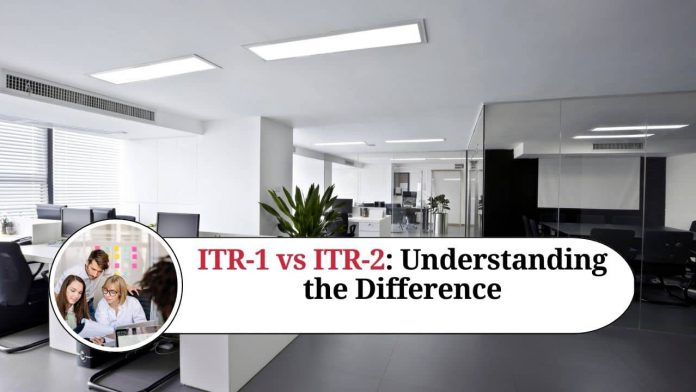Income tax is a crucial aspect of financial planning for individuals in India. While there are several different types of income tax returns (ITR) that individuals can file, the most commonly used ones are ITR-1 and ITR-2. In this blog post, we will discuss the differences between these two types of ITRs and help you understand which one is right for you.
What is ITR-1?
ITR-1, also known as Sahaj, is a simplified tax return form that can be used by individuals who have income from salaries, one house property, and other sources. Individuals who have an annual income of up to Rs. 50 lakhs can use this form to file their tax returns.
What is ITR-2?
ITR-2 is a tax return form that can be used by individuals who have income from salaries, multiple house properties, capital gains, and other sources. Individuals who have an annual income of more than Rs. 50 lakhs are required to file their tax returns using this form.
Key differences between ITR-1 and ITR-2
- Income sources
ITR-1 is primarily meant for salaried individuals with income from one house property and other sources. The other sources of income can include interest income, income from fixed deposits, etc. However, individuals who have income from business or profession, capital gains, or agricultural income exceeding Rs. 5,000 are not eligible to file ITR-1.
On the other hand, ITR-2 is meant for individuals who have multiple sources of income. This includes income from salaries, multiple house properties, capital gains, and other sources. Additionally, ITR-2 is also applicable for individuals who have any foreign assets or foreign income.
- Annual income limit
ITR-1 can be used by individuals who have an annual income of up to Rs. 50 lakhs. If an individual’s annual income exceeds this limit, they must use ITR-2. It’s worth noting that the annual income limit for ITR-1 was increased from Rs. 5 lakhs to Rs. 50 lakhs in the 2019 Union Budget.
- Clubbing of income
If an individual has clubbed income (i.e., income that is added to their total income and taxed as per the applicable tax rate), they cannot use ITR-1. Instead, they must use ITR-2. Clubbing of income typically occurs in cases where a taxpayer’s income is added to the income of their spouse or child.
- Foreign assets
If an individual has foreign assets or foreign income, they cannot use ITR-1. Instead, they must use ITR-2. Foreign assets and income must be reported separately in ITR-2. Individuals who have foreign assets or income must also report the details of their foreign bank accounts, foreign investments, and any income earned from foreign sources.
- Relief under section 90/90A/91
If an individual wants to claim relief under section 90/90A/91 of the Income Tax Act, they cannot use ITR-1. Instead, they must use ITR-2. These sections deal with relief for taxes paid in a foreign country or specified territories, and relief in respect of income from any country with which India has a double taxation avoidance agreement.
- Residential status
ITR-1 can be used only by resident individuals. Non-resident individuals and Hindu Undivided Families (HUFs) cannot use ITR-1. However, if an individual is a non-resident but qualifies as a resident under the provisions of the Income Tax Act, they can use ITR-1.
ITR-2, on the other hand, can be used by all types of individuals, including residents, non-residents, and HUFs.
- Capital gains
If an individual has made capital gains during the financial year, they cannot use ITR-1. Instead, they must use ITR-2. Capital gains can arise from the sale of stocks, mutual funds, property, or any other asset. Capital gains are taxed differently than other types of income, so it’s important to report them accurately.
- Deductions
ITR-1 allows for only a limited number of deductions, such as those under sections 80C, 80D, and 80G of the Income Tax Act. If an individual has other deductions that they want to claim, they cannot use ITR-1. Instead, they must use ITR-2.
ITR-2 allows for a wider range of deductions, including those under sections 80E, 80GGA, and 80QQB. Deductions reduce an individual’s taxable income and can help them save on taxes.
- Form of filing
ITR-1 can be filed only in electronic form (e-filed) or in paper form. However, ITR-2 can be filed in three ways – e-filed, paper filed, or through the digital signature.
- Pre-filled information
ITR-1 comes with pre-filled information such as the individual’s name, address, PAN, TDS details, and employer details. However, ITR-2 does not come with any pre-filled information. The individual has to enter all the required details manually.
Which form should you use?
If you are a salaried individual with income from one house property and other sources, and your annual income is up to Rs. 50 lakhs, you can use ITR-1. However, if you have multiple house properties, capital gains, or foreign assets, or your annual income is more than Rs. 50 lakhs, you must use ITR-2.
Conclusion
In conclusion, ITR-1 and ITR-2 are both important tax return forms that individuals in India use to file their tax returns. Understanding the differences between these two forms can help you determine which one is right for you. Make sure to carefully review your sources of income and annual income to determine which form you need to use when filing your tax returns. It is always a good idea to consult a tax professional if you are unsure which form to use or have any questions about filing your tax returns.
Read more useful content:
Frequently Asked Questions (FAQs)
Q1.) Can an individual with income from business or profession file ITR-1?
No, an individual with income from business or profession cannot file ITR-1. They must file ITR-3 or ITR-4, depending on their income and business structure.
Q2.) Can an individual with foreign income file ITR-1?
No, an individual with foreign income cannot file ITR-1. They must file ITR-2 and report their foreign income and assets.
Q3.) Can an individual with multiple house properties file ITR-1?
No, an individual with more than one house property cannot file ITR-1. They must file ITR-2.
Q4.) Can an individual with income from salary and capital gains file ITR-1?
No, an individual with income from salary and capital gains cannot file ITR-1. They must file ITR-2.
Q5.) Can an individual with income from salary, house property, and interest file ITR-1?
Yes, an individual with income from salary, one house property, and interest can file ITR-1.
Q6.) Can an individual with income above Rs. 50 lakhs file ITR-1?
No, an individual with income above Rs. 50 lakhs cannot file ITR-1. They must file ITR-2.
Q7.) Can an HUF file ITR-1?
No, an HUF cannot file ITR-1. They must file ITR-2 or ITR-3, depending on their income and business structure.
Q8.) Can an individual with losses file ITR-1?
No, an individual with losses cannot file ITR-1. They must file ITR-2 and report their losses.
Q9.) Can an individual file both ITR-1 and ITR-2 for the same financial year?
No, an individual can file only one income tax return for a financial year. They must choose the form that is applicable to their income sources and file it accordingly.
Q10.) Can an individual file ITR-1 if they have made donations to charitable organizations?
Yes, an individual can file ITR-1 if they have made donations to charitable organizations and want to claim a deduction under section 80G of the Income Tax Act. They must provide the required details of their donations in the return.




















